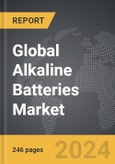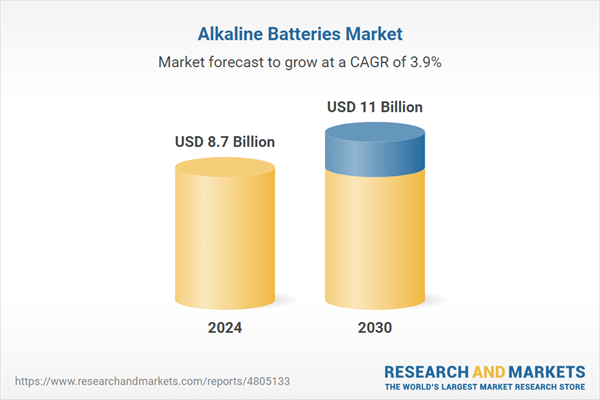Global Alkaline Batteries Market - Key Trends and Drivers Summarized
How Do Alkaline Batteries Work and Why Are They Popular?
Alkaline batteries are ubiquitous in modern life, found in everything from remote controls and flashlights to digital cameras and toys. But how do these small powerhouses work? At the core of an alkaline battery is a chemical reaction between zinc and manganese dioxide. This reaction generates an electric current, which is harnessed to power electronic devices. The name 'alkaline' comes from the potassium hydroxide electrolyte, which is an alkaline substance that allows ions to flow between the anode and cathode. One of the reasons for their popularity is their high energy density, which means they can store a lot of energy relative to their size. Alkaline batteries also have a long shelf life, typically retaining their charge for several years, making them ideal for emergency supplies and infrequently used devices. Additionally, they are safer and less prone to leakage compared to older battery technologies such as zinc-carbon batteries.What Are the Environmental Impacts and Recycling Challenges?
Despite their widespread use, alkaline batteries pose significant environmental challenges. When disposed of improperly, the metals and chemicals in these batteries can leach into soil and groundwater, leading to environmental contamination. The production of alkaline batteries also has an environmental footprint, as mining and refining the necessary metals can result in habitat destruction and pollution. Recycling alkaline batteries can mitigate some of these impacts, but the process is complex and not widely available. Unlike lead-acid or nickel-cadmium batteries, which have well-established recycling programs, alkaline batteries are often discarded in regular household waste. Efforts are being made to improve recycling rates and develop more sustainable battery technologies, but progress is slow. Some regions have introduced regulations requiring manufacturers to finance battery recycling programs, while others are investing in research to make recycling more cost-effective and efficient.How Are Innovations Shaping the Future of Alkaline Batteries?
Technological advancements are continually reshaping the alkaline battery landscape. One significant innovation is the development of batteries with longer lifespans and higher energy capacities, which can reduce the frequency of replacements and the overall environmental impact. Researchers are also exploring new materials and designs to improve efficiency and reduce the ecological footprint of these batteries. For instance, advancements in nanotechnology are being leveraged to create more efficient electrodes, which can enhance the performance of alkaline batteries. Additionally, there is a growing trend towards rechargeable alkaline batteries, which combine the convenience of traditional alkaline batteries with the sustainability benefits of rechargeability. These rechargeable versions are being marketed as a more environmentally friendly alternative, as they can be reused multiple times before disposal.What Drives the Growth in the Alkaline Battery Market?
The growth in the alkaline battery market is driven by several factors. One primary driver is the increasing demand for portable electronic devices, which require reliable and long-lasting power sources. As consumers continue to adopt smartphones, tablets, and other gadgets at a rapid pace, the need for high-performance batteries has surged. Another significant factor is the rise in disposable income in developing regions, which has led to greater consumption of battery-powered products. Additionally, the aging population in many parts of the world is driving demand for medical devices such as hearing aids and blood pressure monitors, which often rely on alkaline batteries. Environmental regulations and consumer preferences for eco-friendly products are also influencing the market, pushing manufacturers to innovate and produce more sustainable batteries. Finally, the expansion of the Internet of Things (IoT) and smart home technologies is creating new opportunities for alkaline batteries, as these applications often require low-cost, efficient, and reliable power sources.Report Scope
The report analyzes the Alkaline Batteries market, presented in terms of market value (USD). The analysis covers the key segments and geographic regions outlined below.- Segments: Type (Primary, Secondary); Application (Consumer Electronics, Toys & Radios, Remote Control, Other Applications).
- Geographic Regions/Countries: World; United States; Canada; Japan; China; Europe (France; Germany; Italy; United Kingdom; Spain; Russia; and Rest of Europe); Asia-Pacific (Australia; India; South Korea; and Rest of Asia-Pacific); Latin America (Argentina; Brazil; Mexico; and Rest of Latin America); Middle East (Iran; Israel; Saudi Arabia; United Arab Emirates; and Rest of Middle East); and Africa.
Key Insights:
- Market Growth: Understand the significant growth trajectory of the Primary Batteries segment, which is expected to reach US$8.1 Billion by 2030 with a CAGR of 4.2%. The Secondary Batteries segment is also set to grow at 3% CAGR over the analysis period.
- Regional Analysis: Gain insights into the U.S. market, valued at $2.3 Billion in 2024, and China, forecasted to grow at an impressive 7.5% CAGR to reach $2.4 Billion by 2030. Discover growth trends in other key regions, including Japan, Canada, Germany, and the Asia-Pacific.
Why You Should Buy This Report:
- Detailed Market Analysis: Access a thorough analysis of the Global Alkaline Batteries Market, covering all major geographic regions and market segments.
- Competitive Insights: Get an overview of the competitive landscape, including the market presence of major players across different geographies.
- Future Trends and Drivers: Understand the key trends and drivers shaping the future of the Global Alkaline Batteries Market.
- Actionable Insights: Benefit from actionable insights that can help you identify new revenue opportunities and make strategic business decisions.
Key Questions Answered:
- How is the Global Alkaline Batteries Market expected to evolve by 2030?
- What are the main drivers and restraints affecting the market?
- Which market segments will grow the most over the forecast period?
- How will market shares for different regions and segments change by 2030?
- Who are the leading players in the market, and what are their prospects?
Report Features:
- Comprehensive Market Data: Independent analysis of annual sales and market forecasts in US$ Million from 2024 to 2030.
- In-Depth Regional Analysis: Detailed insights into key markets, including the U.S., China, Japan, Canada, Europe, Asia-Pacific, Latin America, Middle East, and Africa.
- Company Profiles: Coverage of players such as AEM Canada Group, Inc., Avnet, Inc., Baltimore Battery, Bateria Slany CZ, Sro, Battery Connection Inc. and more.
- Complimentary Updates: Receive free report updates for one year to keep you informed of the latest market developments.
Some of the 46 companies featured in this Alkaline Batteries market report include:
- AEM Canada Group, Inc.
- Avnet, Inc.
- Baltimore Battery
- Bateria Slany CZ, Sro
- Battery Connection Inc.
- Battery Joe
- Battery Specialists
- Bexel Co., Ltd.
- Co Ban Kiat Hardware, Inc.
- Dongwon Systems
This edition integrates the latest global trade and economic shifts into comprehensive market analysis. Key updates include:
- Tariff and Trade Impact: Insights into global tariff negotiations across 180+ countries, with analysis of supply chain turbulence, sourcing disruptions, and geographic realignment. Special focus on 2025 as a pivotal year for trade tensions, including updated perspectives on the Trump-era tariffs.
- Adjusted Forecasts and Analytics: Revised global and regional market forecasts through 2030, incorporating tariff effects, economic uncertainty, and structural changes in globalization. Includes historical analysis from 2015 to 2023.
- Strategic Market Dynamics: Evaluation of revised market prospects, regional outlooks, and key economic indicators such as population and urbanization trends.
- Innovation & Technology Trends: Latest developments in product and process innovation, emerging technologies, and key industry drivers shaping the competitive landscape.
- Competitive Intelligence: Updated global market share estimates for 2025, competitive positioning of major players (Strong/Active/Niche/Trivial), and refined focus on leading global brands and core players.
- Expert Insight & Commentary: Strategic analysis from economists, trade experts, and domain specialists to contextualize market shifts and identify emerging opportunities.
Table of Contents
Companies Mentioned (Partial List)
A selection of companies mentioned in this report includes, but is not limited to:
- AEM Canada Group, Inc.
- Avnet, Inc.
- Baltimore Battery
- Bateria Slany CZ, Sro
- Battery Connection Inc.
- Battery Joe
- Battery Specialists
- Bexel Co., Ltd.
- Co Ban Kiat Hardware, Inc.
- Dongwon Systems
Table Information
| Report Attribute | Details |
|---|---|
| No. of Pages | 246 |
| Published | December 2025 |
| Forecast Period | 2024 - 2030 |
| Estimated Market Value ( USD | $ 8.7 Billion |
| Forecasted Market Value ( USD | $ 11 Billion |
| Compound Annual Growth Rate | 3.9% |
| Regions Covered | Global |









